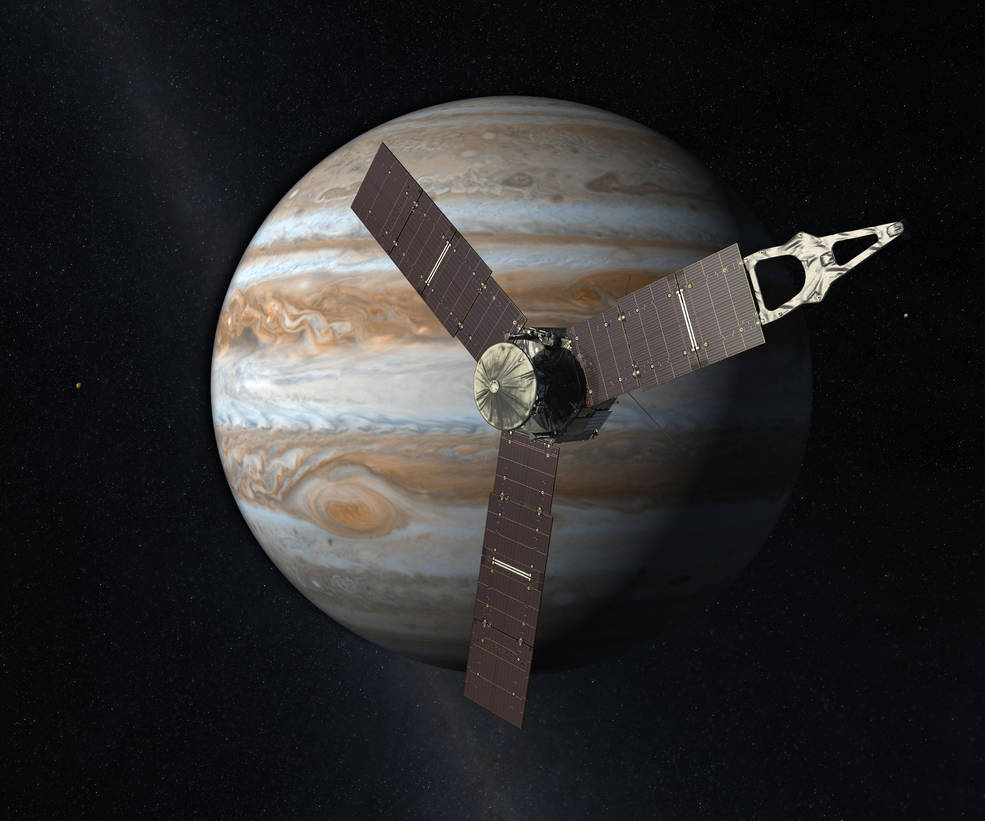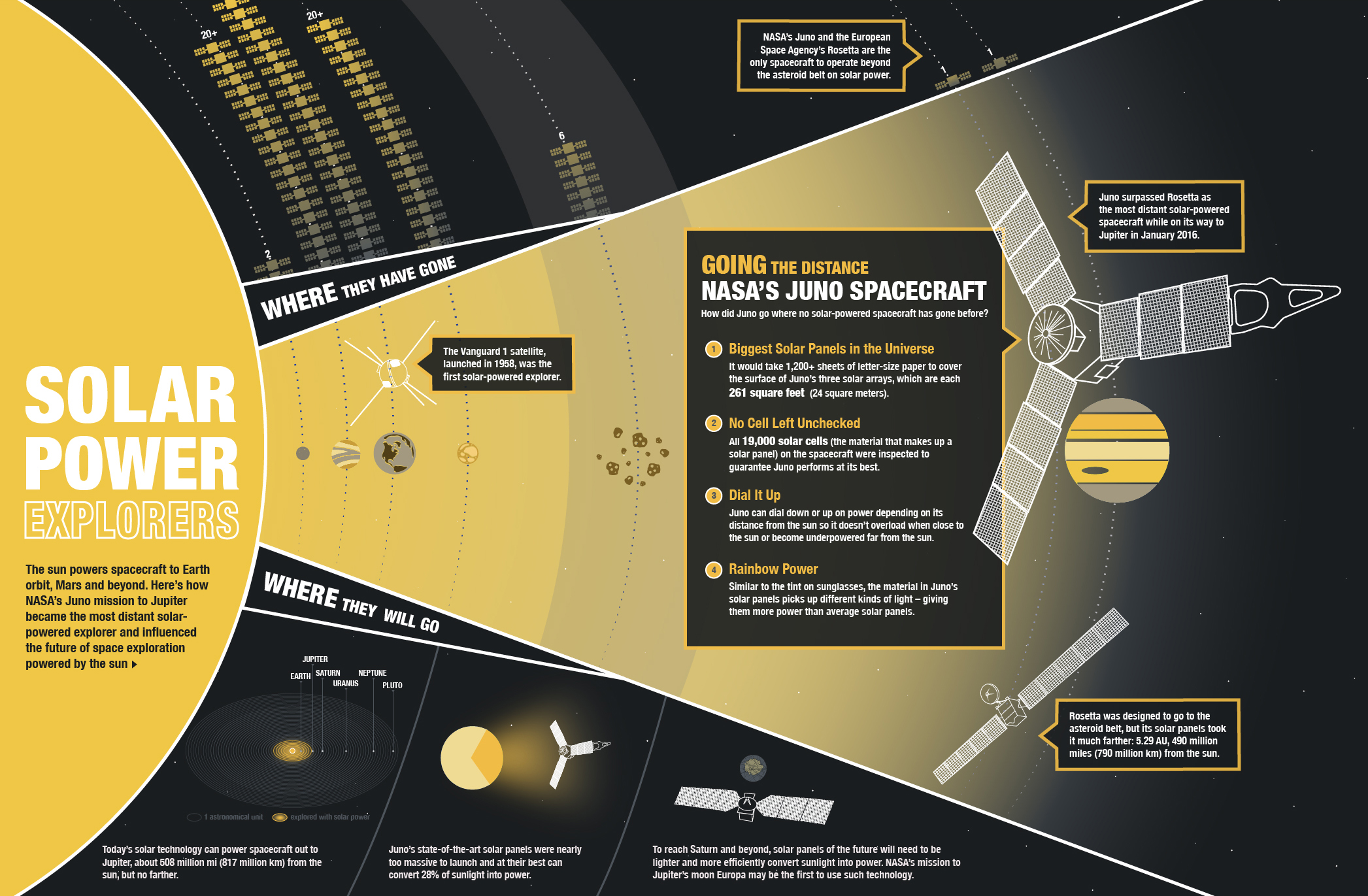
A NASA spacecraft in the home stretch of its five-year journey to Jupiter has just become the farthest-flung solar-powered probe in history.
On Wednesday (Jan. 13), NASA's Juno spacecraft zoomed past the previous record of 492 million miles (792 million kilometers) from the sun, which was held by the European Space Agency's comet-chasing Rosetta mission, NASA officials said.
Juno is scheduled to enter orbit around Jupiter on July 4, and shortly thereafter begin mapping out the gas giant's powerful gravitational and magnetic fields in precise detail. These observations should reveal a great deal about the planet's structure, formation and evolution, including whether or not it has a solid core, mission team members have said. [Photos: NASA's Juno Mission to Jupiter]
"Juno is all about pushing the edge of technology to help us learn about our origins," Juno principal investigator Scott Bolton, of the Southwest Research Institute in San Antonio, said in a statement.
"We use every known technique to see through Jupiter's clouds and reveal the secrets Jupiter holds of our solar system's early history," Bolton added. "It just seems right that the sun is helping us learn about the origin of Jupiter and the other planets that orbit it."

The 4-ton Juno probe carries three 30-foot-long (9 meters) solar panels, which hold a total of 18,698 individual solar cells, enough to generate 14 kilowatts of electricity here on Earth, NASA officials said. But the situation will be quite different at Jupiter.
Breaking space news, the latest updates on rocket launches, skywatching events and more!
"Jupiter is five times farther from the sun than Earth [is], and the sunlight that reaches that far out packs 25 times less punch," Juno project manager Rick Nybakken, of NASA's Jet Propulsion Laboratory in Pasadena, California, said in the same statement. "While our massive solar arrays will be generating only 500 watts when we are at Jupiter, Juno is very efficiently designed, and it will be more than enough to get the job done."

The other eight space missions that have traveled as far as Jupiter have relied on nuclear energy to power their instruments. Juno is making history by leveraging advanced solar-cell technology and an energy-efficient spacecraft and science gear. The probe's mission and orbit design will also help, allowing Juno to avoid Jupiter's shadow and minimizing the spacecraft's exposure to the giant planet's harsh radiation environment, NASA officials said.
The $1.1 billion Juno mission, which launched on Aug. 5, 2011, will continue adding to the distance record for a while yet. The probe will eventually get a maximum of 517 million miles (832 million km) from the sun during its 16-month science mission, NASA officials said.
"It is cool we got the record and that our dedicated team of engineers and scientists can chalk up another first in space exploration," Bolton said. "But the best is yet to come. We are achieving these records and venturing so far out for a reason — to better understand the biggest world in our solar system and thereby better understand where we came from."
Europe's Rosetta mission set the previous distance record in October 2012, while it was chasing down Comet 67P/Churyumov-Gerasimenko. Rosetta caught the comet in August 2014, and in November of that year, the probe dropped a lander called Philae onto the icy object's surface.
Rosetta is still orbiting Comet 67P, which made its closest approach to the sun in August 2015 and is now zooming back toward the outer solar system. The comet and Rosetta are currently about 196.4 million miles (316 million km) from the sun, according to the European Space Agency's Rosetta-tracking website.
Rosetta will not get a chance to break Juno's record. The European probe will end its mission by spiraling down onto Comet 67P's surface on Sept. 30 of this year, when the pair are about 356 million miles (573 million km) from the sun.
Follow Mike Wall on Twitter @michaeldwall and Google+. Follow us @Spacedotcom, Facebook or Google+. Originally published on Space.com.
Join our Space Forums to keep talking space on the latest missions, night sky and more! And if you have a news tip, correction or comment, let us know at: community@space.com.

Michael Wall is a Senior Space Writer with Space.com and joined the team in 2010. He primarily covers exoplanets, spaceflight and military space, but has been known to dabble in the space art beat. His book about the search for alien life, "Out There," was published on Nov. 13, 2018. Before becoming a science writer, Michael worked as a herpetologist and wildlife biologist. He has a Ph.D. in evolutionary biology from the University of Sydney, Australia, a bachelor's degree from the University of Arizona, and a graduate certificate in science writing from the University of California, Santa Cruz. To find out what his latest project is, you can follow Michael on Twitter.
